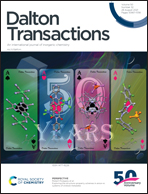Copper-bipyridine grid frameworks incorporating redox-active tetrathiafulvalene: structures and supercapacitance†
Abstract
Redox active tetrathiafulvalene (TTF) and its derivatives when used as electrode additives have exhibited improved energy efficiency and sustainability in batteries. However, the structure–property relationship has not been investigated in detail until very recently. In this work, three redox-active TTF compounds were synthesized, and formulated as [Cu(HL)2(bpa)2]n (1), [Cu(bpe)2(H2O)2]n·2n(HL)·nMeOH·nH2O (2), and [Cu(bpp)2(H2O)2]n·2n(HL) (3) (L = dimethylthio-tetrathiafulvalene-bicarboxylate) for this work. The effects of conjugated state and spacer length of the linkers on structural assembly and band gap as well as the interactions of TTF–TTF/TTF-bpy are discussed. Compound 1 is a bpa and HL co-coordinated 1D Cu(II) polymer. Compounds 2 and 3 are 2D Cu(II)-bipyridine (4,4) MOFs incorporating HL (1−) as free anion columns. The photocurrent density of 2 is larger than those of 1 and 3 due to a strong charge transfer from TTF to bpe in compound 2. The supercapacitance performances of these compounds were evaluated by cyclic voltammetry (CV) and galvanostatic charge–discharge (GCD) techniques. The results revealed that the 2D MOF structures of 2 and 3 are beneficial for good specific capacitance values (Csp). This work revealed the structure–property relationships of TTF derivatives for use as electrode active materials in energy transfer and storage.



 Please wait while we load your content...
Please wait while we load your content...